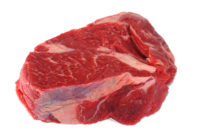Dry Processing Technology
Meat processor automates production and pack-out systems
Wolverine Packing Co. reimagined existing equipment and installed new conveyors and material handling equipment to help scale up its production

The production system receives the meat product, which has been packed into open boxes from two separate lines. Those are divided into four lanes, for a total of eight lanes of conveyors and box taping. Photos courtesy of Automated Manufacturing Technologies.
When Detroit-based Wolverine Packing Co., a third-generation family-owned meatpacking business experienced rapid growth in demand, they needed a high-speed automated case packing and palletizing solution for its greenfield meat processing facility in Forest Park, Mich. They turned to Applied Manufacturing Technologies (AMT), a North American independent automation engineering company, to design, build and install an automated production and material handling lines at two of its five meat processing plants in the eastern market of Detroit. The projects were implemented at the company’s South plant and at its new 180,000-sq.-ft. Forest Park meat processing and freezing facility.
Wolverine’s new production system details
• Box Taping
• Conveyors
• Control Panels
• Weigh Check
• X-ray Systems
After consultations, they decided to adopt a flexible, modular design, which relocated existing equipment and allowed for phased installation of new equipment as well as future expansion. The two-part solution includes a production system and a pack-out system. To accommodate the facility’s startup timeline and evolving needs, equipment needed to be installed in several phases.
Production and pack-out
AMT’s solution for the production system receives the meat product, which has been packed into open boxes from two separate lines. Those two lines are each divided into four lanes, for a total of eight lanes of conveyors and box taping. The two sets of taping lanes merge and AMT’s system handshakes with the customer’s equipment for weight measurement and product x-ray. If either check fails, the box is routed to a reject lane where a quality control operator inspects it.
This high-speed product handling and pack-out system encompasses several unique features such as barcode reading and sortation.
When the taped, weighed and x-rayed boxes leave the production area, they travel via conveyor through a wall to the pack-out area. This area is equipped with a barcode reader, which reads the label and diverts the box to one of three robotic palletizing stations to fulfill a specific customer order. There, multiple boxes of the same product are picked up by a FANUC R2000 robot and loaded onto one of three pallets. With three robotic stations each having three pallets, there are a total of nine pallets concurrently being built.
One pallet dispenser feeds the nine stations via pallet conveyors. When a pallet is filled, the robot places a slip sheet on top. The pallet moves to a wrapping station where it is wrapped for stability before departing to storage. After the pallet leaves the pack-out area, the pallet dispenser and conveyor automatically direct another pallet to that station.

Due to the high-speed nature of the process, the robots must have a common end-of-arm-tooling (EOAT) that is able to pick up any box used in the facility; there is no time to change EOAT between products. AMT developed a proprietary EOAT design, which allows the robot to pick up boxes whose length, width and height vary, in addition to accommodating differences in weights and the number of boxes picked up.
Originally designed for three product induction lanes—each with taping station, control panel and associated conveyors—the product handling system evolved to encompass eight product induction lanes feeding two weight and x-ray systems. Phase one installed the original three product induction lanes and one pack-out robot cell loading three pallets. The next phase added a fourth product induction lane, and the final phase duplicated the earlier product induction equipment with a second four-lane system and added two pack-out area robot cells.
Wolverine’s pack-out system details
•Barcode reader to sort product•Three FANUC R2000 robots each tending three palletizing areas
•Proprietary flexible EOAT picks up boxes of varying size and weight
•One pallet dispenser
•Pallet conveyors
•Slip sheet feeder
•Pallet wrapper
•Manual pallet loading area
This high-speed product handling and pack-out system encompasses several unique features such as barcode reading and sortation as well as utilizing a custom robot EOAT giving flexibility for handling different sizes, weights and number of boxes picked up.
In the product-handling area, modular designs allow for current reuse of existing customer equipment and give flexibility for future modifications. In the pack-out area, each robot in the nine pallet-loading areas can handle any of the customer’s products, and achieves the required high-speed and high-throughput. The nine automated lanes reduce plant floor congestion for palletizing standard orders, and a 10th manual lane can be used for partial, custom-loaded or pallets kicked out of the system. The two-part solution evolved to meet the customer’s production requirements and retained a modular design for flexibility and future expansion.
“AMT has been our partner in automating multiple lines in our Forest Park and South plants,” says Kevin Schenk, Wolverine’s director of technical services. “The upgrades and new lines have allowed us to increase production and maintain flexibility in our system for future expansion. AMT has been very responsive to our needs and has provided us with excellent support.”
For more information, visit www.appliedmfg.com
Looking for a reprint of this article?
From high-res PDFs to custom plaques, order your copy today!






